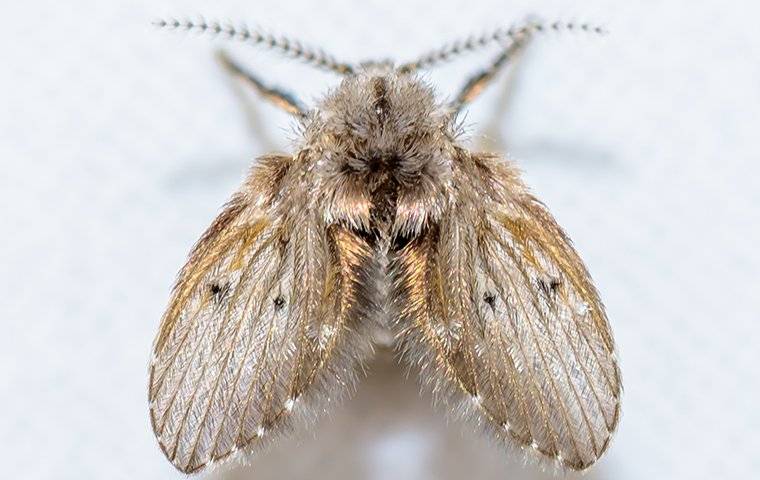Spider Control In New Jersey
Drain flies are a species of fly from the nematoceran family, also known as Psychodidae. These flies hail from the Diptera order. Some may know them as moth flies. They can be found almost anywhere in the United States or the world, as long as there is a standing water supply that has accumulated for at least a week. Drain flies have a distinctive appearance, thanks to their hairy, short bodies that are equipped with wings.
Adult drain flies have leaf-shaped wings and long antennae. They range in size from one-fifty of an inch to one-sixth of an inch and have negligible weight. Drain flies are considered to be weak fliers, only able to travel a few feet at a time. They prefer to move from place to place by hopping and jumping.

About Drain Flies
The drain fly has a very short life cycle, only lasting from one week to three weeks, depending on the temperature of their habitat and availability of food. When they die, there are usually brand new adult drain flies ready to replace them. They thrive in standing water, so homes, where water is circulating through drainage systems on a regular basis, are less susceptible to outbreaks. Due to this fact, your home is most vulnerable to drain fly outbreaks after extended traveling periods
Their predators include spiders and their webs, so their wings are equipped with scales to protect them. Due to their tiny size and ability to hide within pipes and drains, they are not typically susceptible to predators. Their short life span and nocturnal habits serve to keep them safe.
Drain Fly Living Habits and Diet
In the daytime, adult drain flies take care to stay in shady areas. They also spend a fair amount of time on the walls adjacent to your plumbing fixtures and perch themselves on the sides of your tub and shower. A nocturnal creature, drain flies are usually seen fluttering over your sinks and drains during the nighttime hours.
Drain flies also live outdoors, finding homes in shallow swimming pool water, inside of air conditioners, sewers, and even your sump pump. Clogged gutters are another favored area. Adult drain flies are small enough to enter your home through even the tiniest crack in the window or a door left slightly ajar.
The openings of your drainpipes are another common entrance. If you have toilet bowls that do not receive frequent usage or a drainage pan beneath the refrigerator, these can areas of concern. Due to the larvae’s minuscule size, homeowners won’t even notice them swimming in the water.
Drain fly larvae feed on organic matter that has begun to decay, algae, and sediment that they find. They also locate dying organisms within the sediment in which to feed upon, in addition to microscopic animal and plant life. Any vegetation that has begun to experience decay is a key part of their diet.
Adults consume mostly liquid matter. They do not bite or feed on human hosts. Even more surprisingly, drain flies are not the transmitters of any diseases. When their bodies begin to decay, drain flies may cause allergic reactions in those who are susceptible. Those who suffer from bronchial asthma are especially vulnerable. They prefer sweeter liquids, such as fruit juices, nectar, and any sugary substances. This is why they make their home in your drain, so that they may feed on all of the beverages you absentmindedly pour down the sink.
Adult drain flies can only survive for three or four in the absence of food, but if nectar or other sugar-based liquids are available, they can live for up to three weeks without a meal.
Reproduction and Hibernation Habits
Drain flies are able to reproduce in pools of shallow, standing water. When slime, goop, and film accumulate on the sides of drains, gutters, swimming pools, toilets, and the like, that’s where larvae begin to populate. Females can lay eggs whether they are mated or not. Eggs are laid in large masses, ranging from 30 to 100 at a time.
These eggs hatch into larvae within a mere 48 hours. The larvae and pupae then make their home where they can locate the film inside of your drains and standing water supplies. While they can live on fungi and algae found in these places, drain flies can turn on each other and resort to cannibalism when food supplies run low.
Drain flies thrive in moist, warm conditions. Their preferred hibernation temperature is 70 degrees Fahrenheit. Drain flies are typically only found in the summertime or in places with moderate year-round climates. Cold weather kills off more drain flies than any of their predators.
If drain flies are able to find a home indoors, they can continue their development throughout the year, even during the winter. However, even when a suitable indoor hibernation spot is found, colder temperatures are still able to stunt their reproductive habits. Drain flies will remain hidden during colder periods, only emerging once warmer temperatures become the norm.
Reproduction and Hibernation Habits
Latest Blogs
Stay informed about pests and pest related issues in your area!
Dangerous Spiders Of Columbia, MD
If three different spiders are placed in front of you and you are told to pick up the harmless one to win a million dollars, would you feel confident enough to do it?
The Easiest Way To Get Bats Off Your Monmouth County Property
Do you see an increased amount of bats around your home lately? Learn the best way to get bats off of your property.
Are The Fleas In Monmouth County Causing You Headaches?
Prevent and treat fleas with help from Alliance Pest Services in Monmouth County.
Request Your Free Quote
"*" indicates required fields


